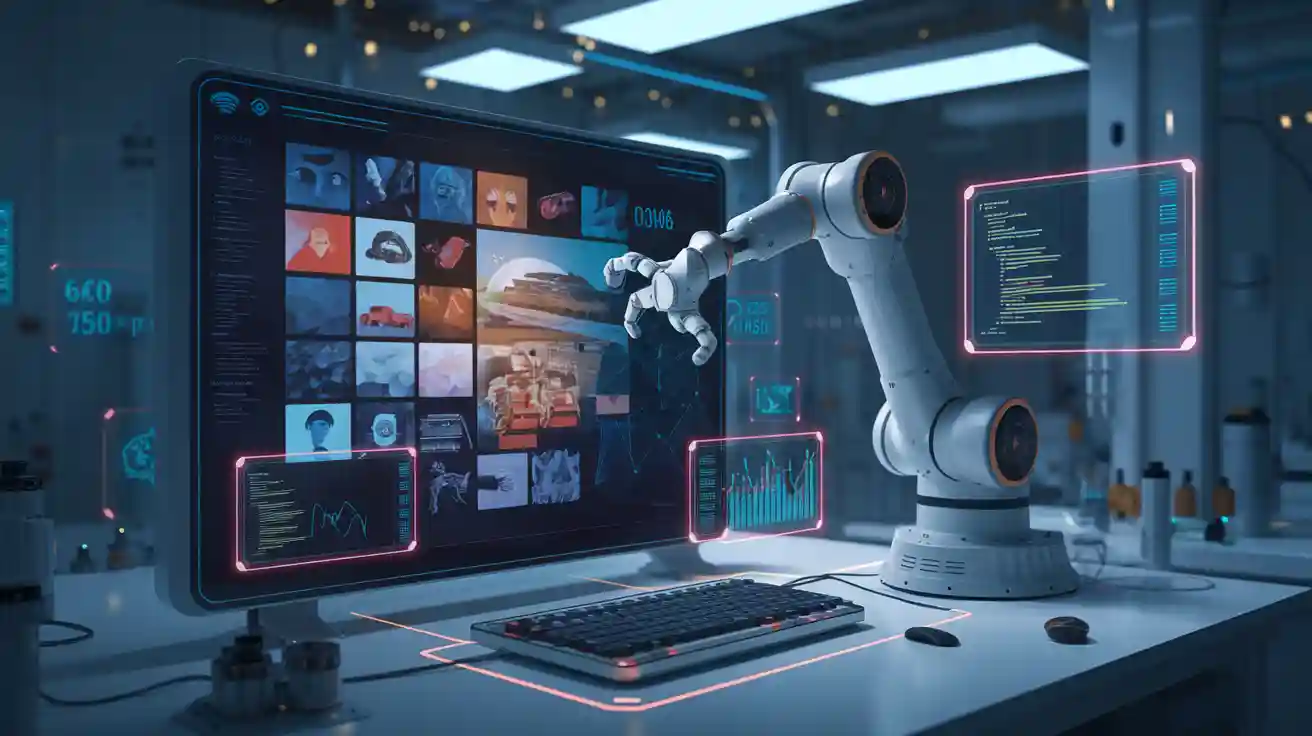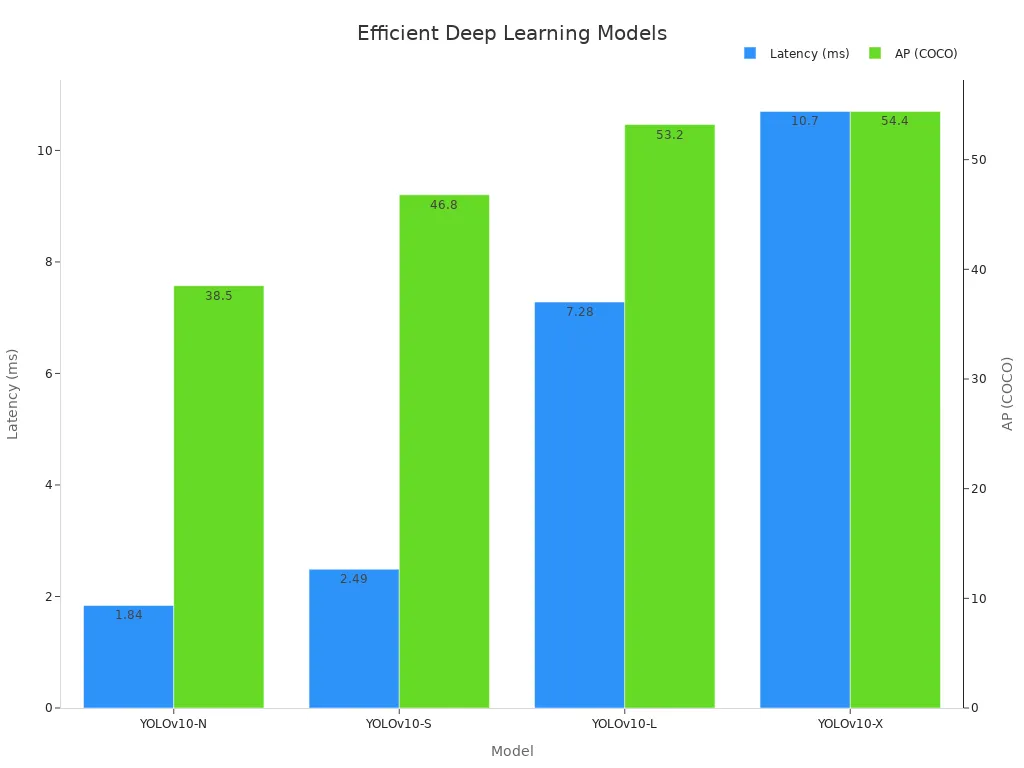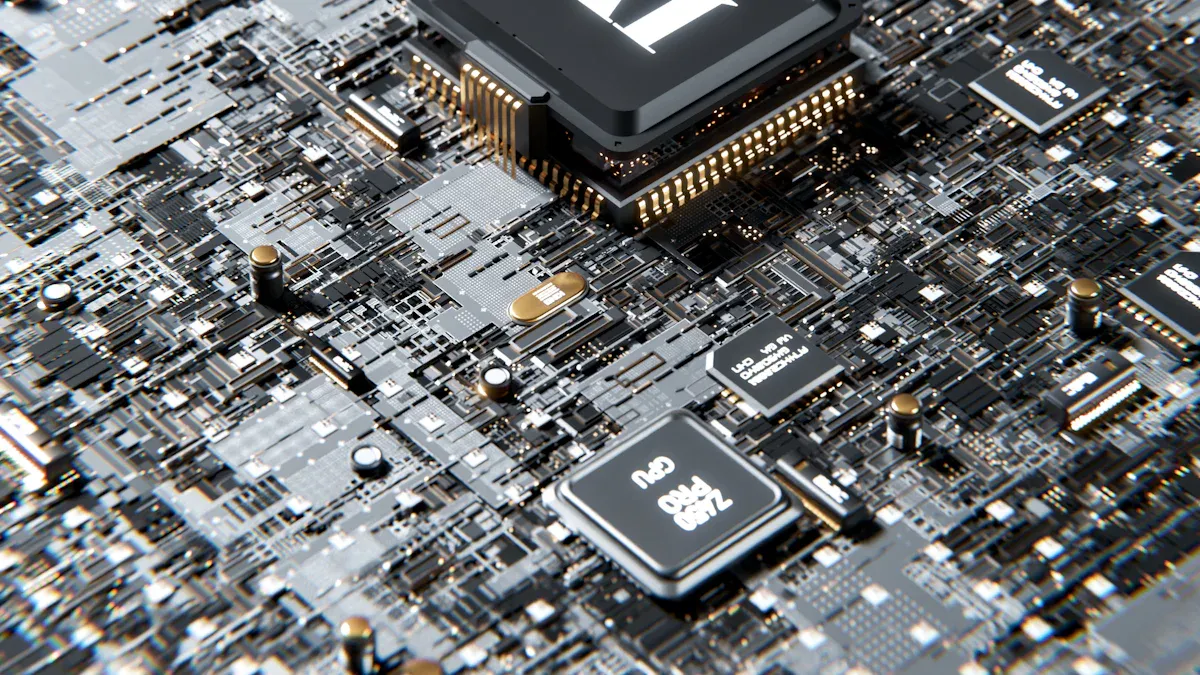Key Image Processing Libraries for Advanced Machine Vision Systems

Image Processing Libraries are essential components of any modern machine vision system. They enable precise and rapid processing and analysis of visual data, making them indispensable for tasks like object detection, where they assist in identifying items within images or videos. In manufacturing, these libraries enhance machine vision systems by improving quality control and detecting defects in real-time.
AI-driven image processing is revolutionizing industries by integrating advanced Image Processing Libraries into machine vision systems. This innovation helps businesses make quicker decisions, achieve higher accuracy, and lower operational costs. The transformation is powered by advancements such as real-time processing through edge computing and enhanced visual search capabilities. With automation-focused industries driving demand, the global market for AI in computer vision is projected to reach $73 billion by 2027.
By leveraging these libraries, you can automate intricate visual tasks, ensuring your machine vision system remains competitive in today’s digital-first landscape.
Key Takeaways
- Image processing tools are important for machine vision systems. They help with tasks like finding objects and checking quality quickly.
- Picking the right tool, like OpenCV for many uses or TensorFlow for smart learning, can make your system work better.
- Free tools give you choices and save money, but paid ones offer help and special features.
- Using these tools in factories and healthcare can make work faster, more accurate, and smarter.
- Think about what your project needs to pick the best tool for your goals and money.
Understanding Machine Vision Systems
What Are Machine Vision Systems
Machine vision systems are advanced technologies that enable machines to "see" and interpret visual data. These systems use cameras, sensors, and image processing libraries to capture and analyze images or videos. You can think of them as the eyes and brain of automated systems, working together to perform tasks like inspection, measurement, and identification. Unlike human vision, machine vision operates with precision and speed, making it ideal for industrial applications.
Key performance metrics define the effectiveness of these systems in industries. For example:
- Faster production cycles increase output.
- Enhanced quality control detects defects early.
- Cost savings result from reduced errors and optimized resources.
- Worker safety improves by minimizing human intervention in hazardous tasks.
- Better data collection supports process optimization.
These systems also provide real-time measurements and operate without physical contact, reducing the risk of damage to delicate products. In manufacturing, they achieve a 100% inspection rate, ensuring high-quality standards.
The Role of Image Processing Software in Machine Vision Systems
Image processing software is the backbone of machine vision systems. It processes raw visual data into actionable insights. For instance, software like LabVIEW FPGA Module performs tasks such as image filtering and color space conversion. This enables your system to identify defects, measure dimensions, or classify objects with high accuracy.
The software also enhances automation by enabling high-speed inspections and consistent evaluations. It reduces human error and ensures reliable results. With advanced features like segmentation and classification, image processing libraries in a machine vision system improve efficiency and reduce costs. By integrating the right software, you can optimize your system for better performance and scalability.
Criteria for Selecting Image Processing Libraries
Performance and Scalability in Real-Time Applications
When choosing an image processing library for machine vision systems, performance and scalability play a critical role, especially in real-time applications. Libraries must process images quickly to avoid delays in decision-making. Efficient algorithms can identify low competency regions without compromising speed. Benchmarks conducted on NVMe SSDs show that libraries like OpenCV and kornia-rs excel in high-performance image processing tasks. These libraries perform well in both single-threaded and multi-threaded scenarios, making them ideal for real-time operating systems.
Performance also depends on image characteristics, such as size and compression ratio. For example, TurboJPEG offers the fastest solution across ARM64 and x86_64 architectures, while jpeg4py delivers maximum performance on Linux systems. By selecting libraries optimized for scalability, you ensure your machine vision system can handle increasing workloads without sacrificing efficiency.
Ease of Integration with Machine Vision Software
Integration with machine vision software should be seamless to maximize productivity. Many libraries come with software development kits (SDKs) that provide tools and APIs for combining algorithms and operators. Open architecture systems enhance flexibility by allowing you to interface with imaging devices and configure applications easily. For example, the Aurora Imaging Library offers a portable API that supports tasks ranging from simple image capture to advanced deep learning models.
Integrated development environments (IDEs) included in some libraries simplify the development process. These IDEs allow you to create applications while retaining access to the full functionality of the tools. Libraries like OpenCV and MATLAB are known for their compatibility with machine vision software, making them excellent choices for projects requiring robust integration.
Support for Advanced Techniques (e.g., Deep Learning)
Modern machine vision systems rely heavily on advanced techniques like deep learning. Libraries must support these techniques to enable tasks such as object detection, image segmentation, and classification. TensorFlow, Keras, and TorchVision are popular choices for implementing computer vision algorithms. These libraries provide pre-trained models and tools for training custom models, making them suitable for projects requiring high-performance image processing.
Computer vision techniques often require libraries to handle large datasets efficiently. For example, the Lunar Environment dataset includes training and test images that demand scalable solutions. Libraries optimized for memory allocation, such as kornia-rs, ensure smooth processing of complex datasets. By selecting libraries that support advanced image processing techniques, you can enhance the capabilities of your machine vision system.
Top Image Processing Libraries for Machine Vision Systems

OpenCV
OpenCV stands out as one of the most versatile computer vision libraries for machine vision systems. It offers a wide range of tools for tasks like image filtering, edge detection, and object recognition. You can use OpenCV to process images in real-time, making it ideal for applications requiring speed and precision.
OpenCV excels in quality assessment through its Laplacian operation for edge detection. This method evaluates image sharpness by analyzing variance, helping you determine exposure levels and aesthetic quality. For example, higher variance in grayscale elements indicates better image clarity.
OpenCV also supports real-time analysis during photo previews and post-capture assessments. This feature enhances user experience by ensuring optimal photographic outcomes. Whether you're working on industrial inspection or autonomous systems, OpenCV provides the performance and scalability needed for advanced machine vision projects.
Scikit-image
Scikit-image is a powerful library designed for scientific image processing. It offers a collection of algorithms for tasks like segmentation, feature extraction, and image enhancement. You can leverage Scikit-image to process complex visual data efficiently, making it a great choice for research and development in machine vision systems.
- Improved Image Quality: The mean square error (MSE) decreases significantly when using Scikit-image, ensuring better image clarity.
- Enhanced Accuracy: Batch size optimization improves accuracy from 57.65% to 74.09%, making it suitable for large-scale applications.
- Efficient Training: Parameter count reduction from 4.8 million to 3.7 million speeds up training processes.
Scikit-image also boosts classification accuracy and recall rates, ensuring reliable results in tasks like defect detection and object classification. Its ability to handle large datasets with reduced computational overhead makes it an excellent choice for machine vision systems requiring high efficiency.
PIL/Pillow
PIL (Python Imaging Library) and its modern fork, Pillow, are lightweight libraries for basic image manipulation tasks. They are easy to use and integrate seamlessly into Python-based machine vision systems. You can use PIL/Pillow for tasks like image resizing, format conversion, and simple filtering.
- Performance Metrics:
| Metric | Description |
|------------------|-----------------------------------------------|
| Loading Time | Quickly loads images from disk to memory. |
| Throughput | Processes multiple images per second. |
| Memory Usage | Consumes minimal memory during processing. |
While PIL/Pillow is not optimized for real-time applications like OpenCV, it remains a practical choice for straightforward image processing tasks. Its simplicity makes it ideal for projects that don't require advanced techniques or high computational power.
TensorFlow/Keras
TensorFlow and Keras are among the most popular computer vision libraries for deep learning applications. These libraries provide a robust framework for building and deploying machine vision models. TensorFlow's dynamic computation graph allows you to adjust models in real-time, making it highly adaptable for testing and optimization. Keras, as a high-level API, simplifies the process of designing and training neural networks, enabling you to focus on solving complex vision problems.
One of the standout features of TensorFlow/Keras is GPU acceleration. This capability enhances processing power, allowing you to train models faster and more efficiently. For example, object detection tasks benefit significantly from this feature, as it reduces training time while maintaining high accuracy. TensorBoard visualization further supports model development by offering detailed monitoring and tuning options.
The performance of TensorFlow/Keras in accelerating deep learning operations is evident in the YOLOv10 model family. These models demonstrate varying levels of speed and accuracy, catering to different application needs:
| Model | Latency | AP (COCO) | Parameters |
|---|---|---|---|
| YOLOv10-N | 1.84 ms | 38.5 | Designed for resource-constrained environments |
| YOLOv10-S | 2.49 ms | 46.8 | Ideal for speed-critical applications |
| YOLOv10-L | 7.28 ms | 53.2 | Balance of speed and accuracy |
| YOLOv10-X | 10.70 ms | 54.4 | High accuracy for compute-intensive tasks |

TensorFlow/Keras empowers you to build scalable and efficient machine vision systems. Whether you're working on autonomous vehicles or industrial automation, these libraries provide the tools needed to achieve high performance.
TorchVision
TorchVision is a key library in the PyTorch ecosystem, designed specifically for computer vision tasks. It offers pre-trained models, datasets, and image transformation utilities, making it an excellent choice for developing machine vision systems. You can use TorchVision to implement advanced techniques like image classification, object detection, and semantic segmentation.
One of TorchVision's strengths lies in its ability to optimize models for resource-constrained environments. For instance, the ResNet50 model, when evaluated on edge computing platforms, demonstrated remarkable efficiency. Quantization reduced the model size by approximately 73-74%, while inference times decreased by 56-68%. Despite these optimizations, the model maintained high accuracy levels. This makes TorchVision particularly effective for autonomous vision systems, where computational resources are often limited.
TorchVision also supports seamless integration with PyTorch, allowing you to leverage its extensive ecosystem for training and deploying models. Its flexibility and performance make it a valuable tool for enhancing image processing tasks in machine vision applications.
MATLAB
MATLAB is a powerful tool for industrial machine vision applications, offering a comprehensive suite of features for image processing and analysis. Its intuitive interface and extensive library of functions make it accessible to both beginners and experts. MATLAB's Statistics and Machine Learning Toolbox is particularly useful for predictive maintenance, enabling you to identify machine tool failure risks with high accuracy.
One of MATLAB's key advantages is its ability to streamline the development process. By minimizing the need for intermediate steps and data transfers, MATLAB reduces the time from prototyping to deployment. This efficiency translates into faster data processing and lower development costs. Additionally, MATLAB's secure environment ensures the integrity of your data, making it a reliable choice for industrial applications.
You can also benefit from MATLAB's visualization capabilities, which allow you to analyze and interpret data effectively. Whether you're working on quality control or predictive maintenance, MATLAB provides the tools needed to optimize your machine vision system.
Industrial Libraries (e.g., Cognex Vision Pro, MVTec Halcon, Matrox Imaging Library)
Industrial image processing libraries are designed to meet the rigorous demands of machine vision systems in manufacturing, automation, and other industries. These libraries offer specialized tools and features that ensure precision, reliability, and scalability for complex visual tasks. Let’s explore three leading industrial libraries: Cognex Vision Pro, MVTec Halcon, and Matrox Imaging Library.
Cognex Vision Pro
Cognex Vision Pro is a widely used library for industrial machine vision applications. It provides a flexible, hardware-independent platform that supports a variety of tasks, including defect detection, barcode reading, and alignment.
- Key Features:
- Advanced pattern-matching algorithms for high-speed object recognition.
- Support for 2D and 3D vision tools to handle diverse inspection needs.
- Easy integration with factory automation systems through its intuitive graphical interface.
Tip: If you’re working in manufacturing, Cognex Vision Pro can help you achieve consistent quality control by identifying defects in real-time.
MVTec Halcon
MVTec Halcon is another powerful library designed for industrial image processing. It excels in handling complex tasks like surface inspection, optical character recognition (OCR), and 3D vision.
- Why Choose MVTec Halcon?
- It offers a comprehensive set of pre-trained tools for deep learning applications.
- Its multi-platform support ensures compatibility with various operating systems and hardware.
- The library includes a unique feature called "Shape-Based Matching," which allows you to detect objects regardless of their orientation or scale.
Halcon’s ability to process large datasets efficiently makes it ideal for industries like automotive and electronics, where precision is critical.
Matrox Imaging Library
The Matrox Imaging Library (MIL) is a robust solution for developers looking to build custom machine vision applications. It provides a rich set of tools for image analysis, pattern recognition, and measurement.
- Advantages of Using MIL:
- It includes a development environment that simplifies the creation of vision applications.
- The library supports GPU acceleration, enabling faster processing speeds.
- MIL’s modular design allows you to scale your system as your requirements grow.
Note: Matrox Imaging Library is particularly effective for applications requiring high-speed inspections, such as food packaging or pharmaceutical production.
Choosing the Right Industrial Library
When selecting an industrial library, consider your specific application needs. For example, if you need advanced deep learning capabilities, MVTec Halcon might be the best fit. If you prioritize ease of integration and user-friendly tools, Cognex Vision Pro could be the right choice. For highly customizable solutions, Matrox Imaging Library offers unmatched flexibility.
Each of these libraries is designed to enhance the performance of your machine vision system, ensuring accuracy and efficiency in demanding industrial environments.
Open-Source vs Commercial Image Processing Libraries
Advantages of Open-Source Libraries
Open-source image-processing libraries offer flexibility and accessibility, making them a popular choice for machine vision software. These libraries are often free to use, which reduces development costs. You can customize them to fit your specific needs, as their source code is openly available. This adaptability allows you to create tailored solutions for unique challenges.
Many open-source libraries also support deep learning and advanced techniques. For example, Cyth Systems uses Neural Vision software to simplify system configuration for users without prior experience. Similarly, Integro Technologies employs tools like Cognex ViDi and MVTec HALCON, showcasing the flexibility of open-source options. Mariner's Spyglass Visual Inspection integrates seamlessly into production lines, reducing false positives and improving quality analytics.
Another advantage is the active community support. Developers worldwide contribute to these libraries, ensuring regular updates and improvements. This collaborative environment fosters innovation and keeps the software aligned with the latest trends in machine vision.
Benefits of Commercial Machine Vision Software
Commercial machine vision software provides robust performance and reliability. These solutions often come with dedicated customer support, ensuring quick issue resolution. They also include comprehensive documentation, which simplifies the learning curve for new users.
The performance metrics of commercial software highlight its advantages. For instance, companies using reliability-centered maintenance programs have reported significant improvements. AboitizPower saved 96.5 power generation hours in nine months by implementing such a program. Additionally, GE Vernova’s Asset Performance Management solution delivered an ROI of over 290%. These results demonstrate the tangible benefits of investing in commercial software.
| Metric | Improvement Range |
|---|---|
| Inventory cost reduction | 5%-10% |
| Increased availability | 2%-6% |
| Reduction in reactive maintenance | 10%-40% |
Commercial software also excels in scalability and security. It can handle fluctuating workloads and complies with regulations like GDPR or HIPAA. These features make it a reliable choice for industries requiring high levels of accuracy and data protection.
Key Considerations When Choosing Between Them
When deciding between open-source and commercial libraries, you should evaluate several factors. Accuracy and speed are critical for real-time applications. Open-source libraries often excel in flexibility, while commercial options provide consistent performance. Scalability is another key consideration, especially for projects with variable workloads.
| Consideration | Description |
|---|---|
| Accuracy | Evaluate how well the API performs on tasks relevant to your use case, such as object detection. |
| Speed | Assess the API’s response time, crucial for real-time applications like e-commerce. |
| Model Updates | Check if the provider offers regular updates to improve accuracy and adapt to new trends. |
| Scalability | Ensure the API can handle fluctuating workloads, especially during peak times like seasonal sales. |
| Provider Support | Look for providers with strong customer service and comprehensive documentation for quick issue resolution. |
| Data Quality | Ensure clean, well-organized training data to avoid inaccuracies in results. |
| Data Security | Verify that the API uses robust encryption and complies with regulations like GDPR or HIPAA. |
| Strategy and ROI | Conduct a cost-benefit analysis and set measurable goals to ensure alignment with business strategies. |
Ultimately, your choice should align with your project’s goals and budget. Open-source libraries are ideal for cost-effective, customizable solutions. Commercial software is better suited for projects requiring high reliability and dedicated support.
Applications of Image Processing Libraries in Advanced Machine Vision Systems

Manufacturing and Quality Control
In manufacturing, machine vision applications have transformed how industries ensure product quality and streamline production. Image processing libraries like OpenCV play a pivotal role in automating tasks such as defect detection, dimensional measurement, and assembly verification. These libraries enable real-time analysis of products on production lines, ensuring that only items meeting quality standards proceed further.
For instance, image classification techniques allow you to categorize products based on their visual attributes. This ensures that defective items are identified and removed before they reach consumers. Techniques like edge detection and pattern recognition enhance the precision of these systems, reducing the likelihood of errors. By integrating image classification software into your machine vision systems, you can achieve consistent results and improve operational efficiency.
Additionally, machine vision systems equipped with object detection capabilities can identify missing components in assemblies or detect surface irregularities. This level of automation not only improves accuracy but also reduces the need for manual inspections, saving time and labor costs. With advancements in image processing techniques, manufacturers can now achieve near-perfect quality control, ensuring customer satisfaction and brand reliability.
Healthcare and Medical Imaging
In healthcare, image processing libraries have revolutionized medical imaging and diagnostics. Machine vision applications in this field leverage advanced computer vision techniques to analyze medical images with unparalleled accuracy. Libraries like TensorFlow and OpenCV enable tasks such as tumor detection, organ segmentation, and disease classification, helping doctors make informed decisions.
For example, image classification plays a critical role in identifying abnormalities in X-rays, MRIs, and CT scans. By using pre-trained models, you can quickly classify medical images into categories such as "normal" or "abnormal." This speeds up diagnosis and ensures timely treatment. Techniques like object detection further enhance these systems by pinpointing specific areas of concern, such as lesions or fractures.
Real-time processing is another game-changer in medical imaging. With the ability to analyze images as they are captured, healthcare professionals can monitor procedures like surgeries or biopsies with greater precision. This reduces the risk of complications and improves patient outcomes. By integrating image processing libraries into medical imaging systems, you can enhance diagnostic accuracy and provide better care.
Autonomous Vehicles and Robotics
Autonomous vehicles and robotics rely heavily on machine vision systems to navigate and interact with their environments. Image processing libraries like OpenCV and TorchVision enable these systems to perform tasks such as object detection, image classification, and object tracking. These capabilities are essential for ensuring safety and efficiency in real-time operations.
In autonomous vehicles, image classification techniques help identify road signs, lane markings, and obstacles. Object detection systems further enhance safety by recognizing pedestrians, other vehicles, and potential hazards. By processing this information in real-time, these vehicles can make split-second decisions, reducing the risk of accidents.
Robotics also benefits from advanced image processing techniques. For instance, robots in warehouses use object detection to locate and pick items from shelves. Image classification software helps these robots sort items based on their visual characteristics, improving the speed and accuracy of order fulfillment. With the integration of machine vision systems, robots can perform complex tasks with minimal human intervention, boosting productivity across industries.
The versatility of image processing libraries makes them indispensable in these applications. By leveraging their capabilities, you can develop systems that are not only efficient but also adaptable to a wide range of scenarios.
Choosing the right image processing library is crucial for building advanced machine vision systems. Each library offers unique strengths, from OpenCV’s versatility to TensorFlow’s deep learning capabilities. Industrial libraries like Cognex Vision Pro provide specialized tools for demanding applications.
Tip: Evaluate your project’s needs, such as real-time performance, scalability, or advanced techniques, before making a decision.
By aligning the library with your specific goals, you can unlock the full potential of your machine vision system and achieve exceptional results.
FAQ
What is the best image processing library for beginners?
If you're new to image processing, start with OpenCV. It offers a user-friendly interface, extensive documentation, and a wide range of tutorials. You can quickly learn basic tasks like image filtering and edge detection.
Can I use open-source libraries for commercial projects?
Yes, many open-source libraries, like OpenCV and TensorFlow, allow commercial use. Always check the library's license (e.g., MIT, Apache 2.0) to ensure compliance with its terms.
How do I choose between open-source and commercial libraries?
Evaluate your project needs. Open-source libraries offer flexibility and cost savings. Commercial libraries provide dedicated support and advanced features. Use this table to compare:
| Feature | Open-Source | Commercial |
|---|---|---|
| Cost | Free | Paid |
| Support | Community-driven | Dedicated team |
| Customization | High | Limited |
Do image processing libraries support deep learning?
Yes, libraries like TensorFlow, Keras, and TorchVision specialize in deep learning. They provide pre-trained models and tools for tasks like object detection and image segmentation. These libraries simplify the integration of AI into machine vision systems.
Are industrial libraries worth the investment?
Industrial libraries, such as Cognex Vision Pro and MVTec Halcon, excel in precision and reliability. They are ideal for industries requiring high accuracy, like manufacturing and healthcare. If your project demands scalability and robust performance, they are worth considering.
Tip: Always align your library choice with your project's goals and budget.
See Also
A Comprehensive Guide to Machine Vision Image Processing
Utilizing Frame Grabbers in Today's Machine Vision Technology
An Overview of SDKs for Machine Vision Applications
